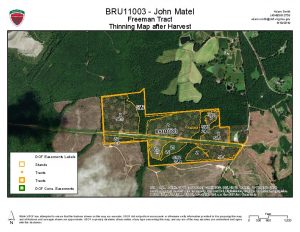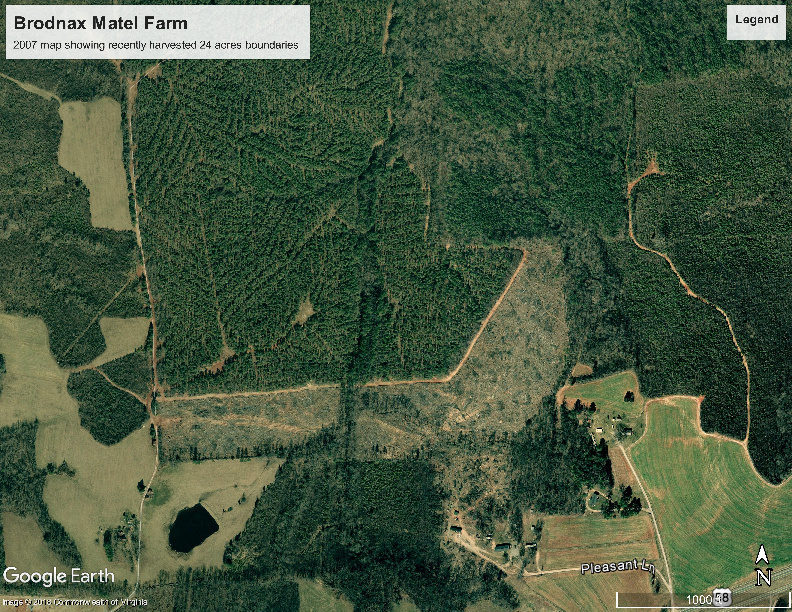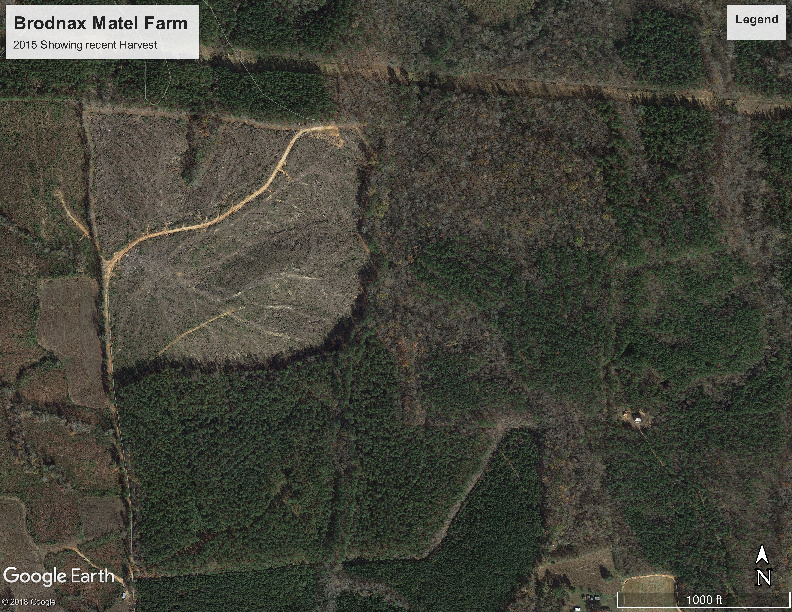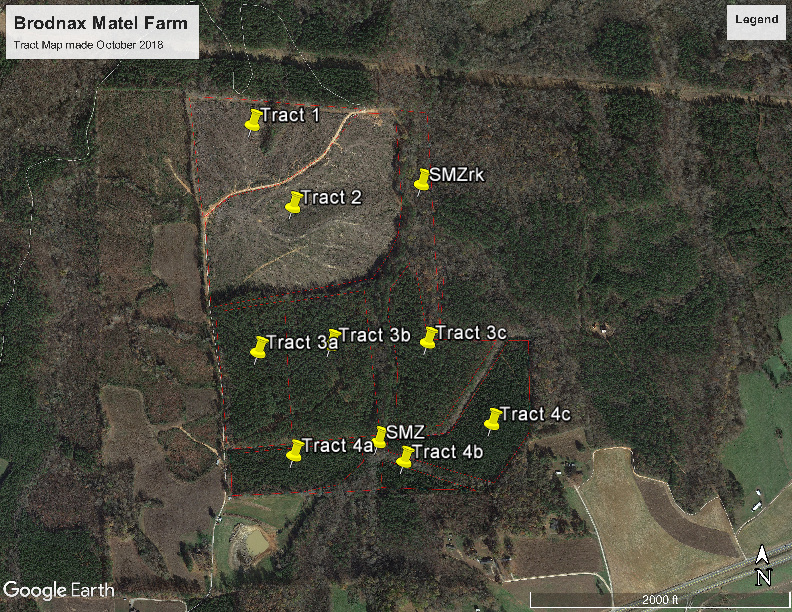Forest Stewardship Plan for
John Matel and Christine Johnson, Freeman Tract
Introduction
This Forest Stewardship Management Plan covers the examination of approximately 103 acres of forestland in Brunswick Country, near Freeman. The tract map is included.
The tract is mostly flat. It includes approximately 65 acres of pine plantation, 25 acres of steam management zones dividing the property roughly in thirds. A power line right of way goes down the middle of the property and covers around 8 acres. The land was likely cleared for agriculture at one time, but has been forest for at least 70 years, as evidenced by old loblolly pines planted in rows that remain in some of the SMZs.
Overall wildlife habitat and forest health are being maintained and improved by thinning, burning and planting feed and pollinator habitat in patches in the woods and along the powerlines, and maintaining soft edges.
No endangered species of plants or animals were noted on the tract.
Forest Stewardship Management Plan
Landowners: John Matel & Christine Johnson
Forested acres: 95
Total acres: 103
Location: Freeman Virginia
Prepared by: John Matel
This Forest Stewardship Management Plan was designed to help guide the management activities of the natural resources on the property for the next ten years. The plan is based on our goals in harmony with the environment around you. Project recommendations are for your consideration.
The Goals for Managing the Property:
- Innovations in forest management to restore longleaf ecosystem
- Soil and Water Conservation.
- Improvement of wildlife habitat.
DESCRIPTIONS & RECOMMENDATIONS OF PARCELS:
PARCEL Z
Acres: 58.1
Forest Type: loblolly and longleaf pine
Species Present: Loblolly & longleaf pine, ailanthus, American sycamore, sweet gum, yellow poplar, eastern red cedar, hackberry, shortleaf pine, Virginia pine, mockernut hickory, white oak, chestnut oak, black oak, green ash, mulberry, sassafras, black cherry, persimmon, holly, black locust, blackgum, and red maple.
Age: loblolly planted in 1996. Longleaf interplanted 2018/19
Size: loblolly are chip and saw and some saw timber
Quality: excellent
Trees/acre: Adequately stocked for our management objectives, i.e. thinned to 50 BA to allow greater wildlife habitat including grasses and forbs.
Growth Rate: excellent.
Recommendations:
The vegetative nature of this parcel provides benefits to wildlife due to the diversity of ground covers and understories. We plan to
- Do understory burns every 2-4 years
- Create field borders on this parcel
- Maintain and enhance diverse and native ground covers
PARCEL Z1
Acres: 4
Forest Type: longleaf pine planted in 2012
Species Present: Longleaf & loblolly pine, sumac, some oak and bald cypress
Age: Planted in 2012
Size: Tallest around 15 feet high in 2018
Quality: Excellent
Trees/acre: Adequately stocked. Trees are widely spaced on purpose to allow wildlife and understory growth
Growth Rate: Excellent
Recommendations:
Parcel will be burned every 2-4 years in order to maintain longleaf pine and early successional habitat under them.
PARCEL Z 2
Acres: 7
Forest Type: Loblolly & longleaf pine.
Species Present: Loblolly and longleaf pine, some bald cypress
Age: Loblolly planted 1996. Longleaf pine planted 2018/19
Size: chip and saw to sawtimber, loblolly; longleaf are seedlings
Quality: excellent
Trees/acre: Adequately stocked
Growth Rate: Excellent
Recommendations:
Half of the parcel was clearcut in 2018 and rest heavily thinned. The clearcut will be planted with longleaf pine 10×10 of a little tighter and interplanted with loblolly on the rest.
PARCEL SMZ
Acres: 25
Forest Type: Mixed hardwoods and pine.
Species Present: Loblolly pine, ailanthus, American beech, American sycamore, sweet gum, yellow poplar, eastern red cedar, hackberry, shortleaf pine, Virginia pine, mockernut hickory, white oak, chestnut oak, black oak, green ash, mulberry, sassafras, black cherry, persimmon, holly, black locust, blackgum, and red maple.
Age: 40 to 80 years
Size: Various sizes including significant saw timber. (10 to 18 inches in diameter)
Quality: Good to excellent
Trees/acre: Adequately stocked
Growth Rate: Good to excellent
Recommendations:
This parcel is in place to protect water quality and to provide wildlife corridors. We will periodically examine the SMZs for invasive species and treat as appropriate. Beyond that, this area will be generally left to natural processes, with interventions only in the case of some sort of disaster, such as fire or particularly violent storms.
Non-Forest Border
About 8 acres of the property is under power lines. This is managed as a long border area. It is planted with native grasses and forbs and will be managed to maintain early succession habitat by the use of fire and mowing.
Wildlife Recommendations
Field Borders
Field borders are established along woodland edges and major drainages. Field borders create vegetative transition zones between cover types. Such zones are much more attractive to wildlife than the abrupt change that often occurs, for example, between field and forest.
Daylighting consists of cutting most, of not all, trees in a specified area to encourage and accelerate the growing and non-shade tolerant plants. Existing shrubs, vines and herbaceous (non-woody) plants should be left undisturbed to the extent possible. Woodland edges should be daylighted to a depth of 40 feet, recognizing that remaining trees will quickly reach out to shade the opening. Field borders established by daylighting have the advantage of taking no acreage from existing open land.
Where the loss of open land is not a major concern, a natural border can also be created by allowing woody plants to invade and encroach into existing open edges. “Encroachment” borders, like those daylighted, should be wide, at least 30 feet. Where grass is well established, this should be destroyed by plowing or by the use of a herbicide. This will speed up the invasion of the more desirable “border plants.” The establishment of field borders using this practice requires the least expense and labor.
If natural borders seem undesirable (perhaps from an aesthetic standpoint); the planting of shrubs is an option frequently used. Additionally, with the use of these, the results are more reliable and, in the long run, maintenance will be less (natural borders will be invaded with trees that should be cut back periodically). The transition from field to tree line should be gradual in height. Here, shrub plantings also have an advantage. By proper selection and arrangement of shrub varieties, the border can be a stair step from field to treetop. Taller growing shrubs, such as Mountain Ash should be placed next to the woods. Lower growing varieties, such as the shrub dogwoods or bi-color (VA-70) lespedeza should be placed against the taller varieties. The total depth of a shrub border should be at least 20 feet.
The final touch to any border is the establishment of a herbaceous strip along the open side. These may not be necessary, if the border joins an annually tilled or recently fallowed field. If not, a strip 10 to 20 feet wide parallel to and adjoining the border should be plowed or disked. This can remain fallow for up to two or three years, allowing annual native plants to grow back many of which provide excellent wildlife food and cover. Or, if desired, these strips can be seeded using one of the warm-season grasses, white clover, Korean or Kobe lespedeza, or one of the locally well suited agricultural grains.
Borders need not completely rim every field or fringe every wood line. Yet, they should be employed to the greatest extent possible. Good field borders provide food, cover, and security. Perhaps equally important, they provide a most favorable “edge,” a critical component in the habitat chosen by most wildlife.
Open Fields
Probably the best practice to enhance open fields for wildlife is the establishment of field borders. These have been described.
Thinning
Parcel Z
This area was thinned in 2018 to 50 BA, with clearings of approximately ¼ acre in each acre. Thinning will increase their ecological value to wildlife. Thinning allows sunlight to reach the forest floor which stimulates the growth of forbs, legumes, and other herbaceous material. Tree tops left on the forest floor provide temporary cover and nesting places. Thinning can also increase mast production of healthy oaks and hickories.
Snags
All Parcels except the grassland:
Snags, dead or deteriorating trees, are an important habitat component in forests for wildlife. The availability of snags on forest lands affects the abundance, diversity and species richness of cavity nesting birds and mammals. Two to four snags per acre should be maintained in the forest. Such trees provide forage, cover, perches, and nesting sites for wildlife species such as raccoons, bats, flying squirrels, snakes, owls, woodpeckers, bluebirds (near open areas), and wrens, to name but a few. When snags are lacking in a forest, they can be created by girdling trees of poor quality or health.
Forest Openings
Parcels Z
This area benefits from the development of forest openings to encourage the development of low growing plants. Approximately twenty ¼ acre openings were created by cutting all the trees in these areas. The area will be planted with longleaf pine and burned every 2-4 years to maintain the longleaf and maintain early successional habitat under them.
Power Line Right-Of-Way
The power line right of way is planted with native grasses and forbs and maintained in early successional habitat by fire and mowing.
Prescribed Burning
Periodic burning is a tool used. Please see above.
Logging Roads
Soil erosion can be prevented through the careful location and maintenance of logging roads. Dominion Power maintains an access road along the power lines. This is the only regular road on the land.
Broad base dips and drainage ditches should be placed 20 feet apart on steep slopes and 50 feet apart on medium slopes. Loading areas should be seeded in game food after harvest. When logging is complete, ruts and gullies should be filled and the road should be out-sloped slightly. Closing of roads to unauthorized traffic will prevent damage to newly sown grass or wildlife food. More information is available in the enclosed brochure.
Skid trails, haul roads, and log decks should be seeded with a mix of orchard grass and ladino clover.
Prepared by: _John Matel____________________________
Suggested Schedule of Management Activities
| Year | Parcel | Activity |
| 2018 | Z | Thinning to 50 BA |
| 2018 | Z, Z1, & Z2 & power line | Prescribed burning |
| 2018 | Z 2 | Plant longleaf and bald cypress |
| 2019 | Z | Plant longleaf (December) |
| 2021 | Z & Power line | Prescribed burning |
| 2022 | Z1 & Z2 & power line | Prescribed burning |
| 2023 | SMZ | Remove invasive species |
| 2024 | Z & power line | Prescribed burning |
| 2025 | Z1 & Z2 & power line | Prescribed burning |
| 2026 | SMZ | Remove invasive species |
| 2028 | Z | Harvest loblolly sawtimber |
This schedule may need to be adjusted depending on financial needs, timber markets, timing of actual harvest, and availability of contractors.





